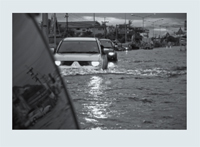March 2013
Change in the Weather
As changes in climate become more severe, engineers are making an effort to prepare for the future.
BY MATTHEW McLAUGHLIN
Across the U.S. and in multiple industries and disciplines, engineers are taking climate change into account in their work. It's a trend that is gaining ground as the nation's infrastructure continues to face weather it wasn't designed to withstand, placing the public health, safety, and welfare at risk.
In the last 15 years, there has been an 85.7% increase in the number of U.S. weather disasters that have caused $1 billion or more in damages when compared to the previous 15 years, according to information from the National Climatic Data Center and the Department of Commerce. While higher property values and increasing populations in areas vulnerable to weather are contributing to this rise, the majority of scientists agree climate change is also making extremes in weather more likely.
"I think what you're seeing now is a recognition, in the face of these extreme events, that this topic needs consideration," says Rachelle Hollander, director of the NAE's Center for Engineering, Ethics, and Society.
The New Climate
 A report by the National Climate Assessment and Development Advisory Committee released in January for public review notes the implications for the built environment and other aspects of society.
A report by the National Climate Assessment and Development Advisory Committee released in January for public review notes the implications for the built environment and other aspects of society.
"[Climate change] will be disruptive to society because our institutions and infrastructure have been designed for the relatively stable climate of the past, not the changing one of the present and future," the report says. "For example, building codes and landscaping ordinances will likely need to be updated not only for energy efficiency, but also to conserve water supplies, protect against insects that spread disease, reduce susceptibility to heat stress, and improve protection against extreme events."
The Army Corps of Engineers, the National Academy of Engineering, engineering firms, communities, and others are taking action.
NAE's Center for Engineering, Ethics, and Society is one such group leading the Climate Change Educational Partnership. The partnership is focused on three themes: climate impacts on engineered systems and their adaptation, changes in engineered systems required to mitigate greenhouse gas emissions, and the creation of novel technological systems to engineer the Earth's climate system.
The proposal for the partnership was put together two years ago because so little was being done about the effects of climate change on engineering, says Clark Miller, associate director of the Center for Nanotechnology in Society at Arizona State University and codirector of the partnership's original proposal. "We thought that was a problem and, in particular, what we thought was basically the biggest vulnerabilities we're going to face as a society are ones that are going to arise as a consequence of our engineered systems and the vulnerabilities in those engineered systems."
To address the problem, the partnership began forming a national network to enhance education on the subject of climate change and engineering. That first phase of the partnership's work ended in January with a capstone workshop titled "Climate Change and America's Infrastructure: Engineering, Social, and Policy Challenges," held at Arizona State University.
The workshop explored actual cases of engineered systems impacted by climate change, public policy implications, educational interventions in postsecondary and informal settings, and societal and ethical considerations in preparing America's infrastructure for the impacts of climate change. It also brought together faculty and administrators from engineering schools and colleges; engineering societies; federal officials; state, city, and county infrastructure officials; science museum personnel and informal educators; engineering and science ethics scholars; and STEM educators.
Top Down Change
 For the Army Corps of Engineers Hurricane Katrina was the wakeup call to begin talking seriously about climate change, according to Senior Lead for Global and Climate Change Kathleen White. In addition to President Obama's 2009 Executive Order 13514, which requires federal agencies to mitigate climate change through the improvement of energy and water conservation and reduction of greenhouse gas emissions, a policy for "mainstreaming" climate change adaptation has been adopted by the Corps.
For the Army Corps of Engineers Hurricane Katrina was the wakeup call to begin talking seriously about climate change, according to Senior Lead for Global and Climate Change Kathleen White. In addition to President Obama's 2009 Executive Order 13514, which requires federal agencies to mitigate climate change through the improvement of energy and water conservation and reduction of greenhouse gas emissions, a policy for "mainstreaming" climate change adaptation has been adopted by the Corps.
"Mainstreaming climate change adaptation means that it will be considered at every step in the project lifecycle for all USACE projects, both existing and planned?to reduce vulnerabilities and enhance the resilience of our water-resource infrastructure," the policy statement reads.
"[Climate change] potentially puts the health, safety, and well-being of the public at risk," White says. "We need to be concerned about things that impact the public. That means that we have to consider things like the changing frequency of droughts or floods or storm events or those kinds of natural disasters of different types, and we have to be prepared for them. We have to include those in our designs and our constructions."
Consideration of the effects of climate change on infrastructure is not limited to the federal government. At some point it seems, all levels of government and engineering disciplines have had a similar wakeup call.
In southeast Florida, Broward, Miami-Dade, Monroe, and Palm Beach counties have formed the Southeast Florida Regional Climate Change Compact to mitigate the causes and adapt to the consequences of climate change.
While currently still in the approval process, an action plan released by the compact in October 2012 has been approved by two of the four counties. The 84-page document includes more than 100 action items aimed at both reducing greenhouse gas emissions and adapting to the regional and local impacts of climate change.
The counties want to be sure that mitigation and adaptation are kept in mind, says Nancy Gassman, Broward County's Natural Resources Administrator. "Climate change is completely changing the way that our infrastructure has to work and those changing conditions will have to be taken into consideration in design and construction and maintenance," she adds. "So I don't think there's going to be a project built in the country that doesn't have an aspect of this new climate environment that's going to need to be considered."
Across the country in Colorado, Jonathan Koehn says communities are starting to think differently. The regional sustainability coordinator for the City of Boulder adds that these communities are becoming more sophisticated in their overall planning efforts and "recognizing that the impacts are shifting and becoming much more prevalent. Things like our 100-year flood events are no longer 100-year flood events."
"Things are going to be different," agrees James Jones, P.E., distinguished service professor in the University of Florida's Biological and Agricultural Engineering Department. While sometimes disheartened by how long it has taken to address climate change, Jones says engineers are currently working on many of the problems posed by climate change in agriculture. "A lot of it is being done, so I am generally optimistic."
Even firms are addressing climate change through self-imposed plans and regulations, such as a challenge by the American Institute of Architects to design net-zero energy buildings by 2030.
NSPE member Jeffrey Roman, P.E., is national director of engineering for a firm that has signed onto the AIA challenge—Little Diversified Architectural Consulting in Charlotte, North Carolina. "We feel very strongly about that challenge and about the goal of that challenge," he says.
Like others, Roman also believes adaptation too will drive changes in engineering. "What we have experienced and what may be occurring will drive changes in the future, and I think as engineers we play an absolutely crucial role in this," he says. "We as engineers have a critical, critical role to play with this, and I think it's one that all of us realize whether we want to or not."
Change or Die
 The need for and obligation of engineers to solve the problems associated with climate change is something many people are thinking about. That is why so many are saying the issue must be addressed, whether in big federal projects, retail space designed by a private firm, or across disciplines.
The need for and obligation of engineers to solve the problems associated with climate change is something many people are thinking about. That is why so many are saying the issue must be addressed, whether in big federal projects, retail space designed by a private firm, or across disciplines.
There's something else, however, that engineers also need to consider, according to David Lapp.
Lapp, a professional engineer who serves as secretariat on Canada's Public Infrastructure Engineering Vulnerability Committee and the World Federation of Engineering Organizations' Engineering and the Environment Committee, cautions that in coming years engineers could become liable for not taking climate change adaptation into consideration.
"It's something to be watching for in the profession going forward—what are the professional liability issues associated with climate change?" he says. "If 10 years from now your structure fails due to a climate event, one of the questions could be: Did you take account for climate change in your design?"
Few engineers would want to have to say no in such an instance, and Lapp believes such an instance is coming. "We need to have the tools and processes in place to deal with that issue."
With many calling for climate change mitigation and adaptation, engineers must themselves adapt to the world's changing climate. Right or wrong, for better or worse, what governments, clients, firms, and the public believe about climate change will affect the work of engineers now and into the future.
As USACE Senior Lead for Global and Climate Change Kathleen White puts it, there are hard choices ahead. "It's going to take courage," she says.


